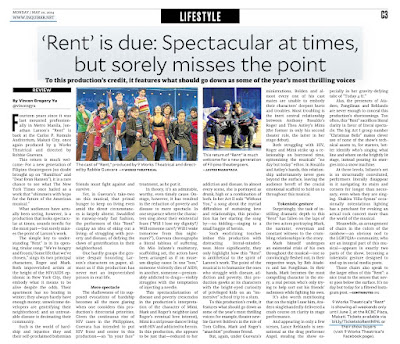Two musicals and popular success
Monday, December 30, 2024
The Year in Philippine Theater (2024)
Two musicals and popular success
Monday, October 14, 2024
PDI Review: 'Othello' by CAST; 'Six' - The 2024 International Tour in Manila
In Company of Actors in Streamlined Theatre’s (CAST) production of “Othello,” the Shakespearean play has become a literal in-your-face confrontation of gender-based violence.
The play’s basic premise is almost straight out of Filipino primetime melodrama: Iago, a junior military officer, manipulates his commander Othello into thinking his wife Desdemona is cheating on him.
Directed by Nelsito Gomez in the 100-seater Mirror Studio, this production unfolds mere feet from the audience. Watching it not only feels like being a co-conspirator to the signature Shakespearean silliness dotting the proceedings, but also like a voyeur witnessing the unflinching violence inflicted by the story’s men on their wives.
The physical proximity renders the production’s best quality more immediate: Above all, this “Othello” is a triumphant dissection of gender power relations.
In Maronne Cruz’s portrayal of Desdemona’s maidservant Emilia, the play finds its most consummate vessel, the actress intelligently communicating, through superb command of affect and language, a trapped existence between the old world of patriarchal submission and the possible new world of feminist defiance.
Further, Gomez’s choice to stage the play in modern dress, with modern props (e.g., beer bongs in a party scene), while having the actors spout Shakespeare’s original lines, helps convey the notion that gender-based violence has always transcended eras, generations, and continents.
Racial politics
However, an imbalance afflicts this production as it sidesteps the text’s other crucial element. For while on the surface, Iago’s manipulation of Othello appears rooted in the former’s discontent with how the commander runs the military, the unmistakable subtext is that Iago’s—and, for that matter, most of the other characters’—disdain for Othello is racially motivated.
Othello is a Moor—the term for the predominantly darkskinned Muslims in a predominantly White, Christian Mediterranean Europe. When Iago (Reb Atadero, deliciously devious) exclaims repeatedly that he “hates the Moor,” one very well knows it isn’t merely because he despises Othello’s governance.
Barely touching the play’s inherent racial politics, this “Othello” becomes a missed opportunity to comment on the present, with the Caucasian superpowers actively abetting the genocide in predominantly Arab-Muslim Gaza. Perhaps this is ultimately a wise decision, what with race being a considerably less topical issue than sexual violence in the Philippines.
The more alarming consequence of this reluctance to grapple with racial politics is this production’s inadvertent perpetration of dangerous racial stereotypes. Tarek El Tayech’s Othello, hounding this play like a colossus, speaks his lines with an ostensibly Middle Eastern accent; beyond such physical flourishes, the production hardly complicates the race-based otherness of its titular character.
Retooling the classics
At the end of Act I, vowing to punish Desdemona for her purported infidelity, El Tayech’s Othello momentarily unshackles himself from archaic Shakespearean English and breaks into Arabic prayer, with Atadero’s Iago looking on. Nothing else is made of that supposedly crucial scene, imbuing it with an exoticizing effect that makes one question the necessity of this one-time-only linguistic shift.
As Othello slowly descends into jealous madness throughout Act II, eventually battering and strangling his wife, El Tayech’s portrayal only makes Othello look like a crazed abuser: the stereotype of the uncivilized, hostile, predatory Arab Muslim come to life.
Still, its flaws notwithstanding, this “Othello” is further proof that its director should keep pursuing his modern-day retoolings of the classics. Notably, Gomez was responsible for last year’s “Uncle Jane,” his present-day adaptation of Anton Chekhov’s “Uncle Vanya” that was, in my view, 2023’s best play—so precise and expansive as a rumination on hope and hopelessness in the time of COVID-19.
In the larger scheme of things, this is the theater we need more of—one that incessantly tickles and provokes the mind, no matter how imperfect.
Dazzling technicals
Meanwhile, in the 1,700-seater theatre of Solaire Resort and Casino, Parañaque City, the Broadway and West End sensation “Six” has made its Philippine premiere. This is musical theater as a pop concert—and the production, supercharged with some of the most dazzling and precise uses of technicals Manila theater has witnessed of late, delivers without question.
Essentially an 80-minute revue, the musical is about the six wives of Henry VIII (hence the title), but the wives have morphed into pop star archetypes (one pays homage to Beyoncé, another to Ariana Grande), the stories of their individual rise and fall in Henry’s court (and heart) comprising individual songs.
It’s a concept that should come across as basic, but what “Six” really is is satisfying fun, serving one bop after another, to use the urban slang, and dishing out Tudor history like addictive pieces of gossip—all while approximating a theater nerd’s idea of a rollickingly good time at the club.
Never mind that, in a bid to ensure the audience really gets its message, it ends up over-explaining its themes of feminist empowerment, as if doubting the intellect of its Gen Z and Alpha audiences.
But maybe being easy isn't always a bad thing. Exiting the theater, I overheard a mother ask her son, "Do you know what the patriarchy is?" Truly, the real magic of the theater lies in the cross-generational conversations it sparks after the curtains have fallen.
Monday, May 27, 2024
PDI Review: 'One More Chance' by PETA; 'Bar Boys' by Barefoot Theatre Collaborative; 'Buruguduystunstugudunstuy' by Full House Theater Company
Monday, May 20, 2024
PDI Review: 'Rent' by 9 Works Theatrical
This return is much welcome: For a new generation of Filipino theatergoers (no doubt brought up on “Hamilton” and “Dear Evan Hansen”), it is a rare chance to see what The New York Times once hailed as a work that “shimmers with hope for the future of the American musical.”







